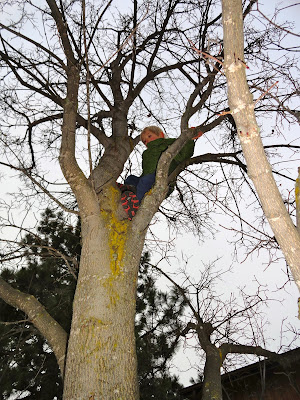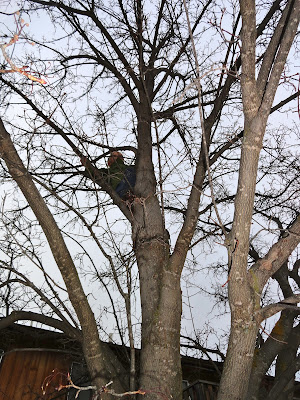Well, slower is better for yogurt making anyway.
Tends to make the yogurt feel smoother in the mouth
and be nice and tangy.
You can't rush tangy.
We start with a gallon of full fat organic milk.
Raw is best but it's hard to find in the winter.
So I buy milk that has been very lightly pasteurized.
More good bugs this way.
Dump in all into a large heavy pot.
A big soup pot works well.
You're gonna need a candy thermometer
and something to stir with that's wooden or silicone.
Set the heat on lowish.
And stir.
And stir.
And stir.
And stir. You need to make sure the milk doesn't scorch.
So you kinda gotta pay attention.
And . . .
stir.
When the temperature reaches 185 degrees Fahrenheit
(yes, I had to look up how to spell that one),
you're ready to think about the cultures.
Don't add them yet, the heat would kill them and that'd be sad, right?
The cultures are the things that make the yogurt sour and yummy tasting
instead of just tasting like rotten milk.
Cultures can be the scrapings from a kind of yogurt you like.
They can be an entirely different kind of yogurt altogether
(maybe goat milk for an adventure).
Or they can be your favorite probiotic capsule.
It should be a good quality one and kept in the fridge (doh).
One of the joys of making your own yogurt is that you can have
W.A.Y.
more than the 3 or four strains of live cultures that
usually come in comercial yogurts.
So, be creative. See what will grow. See what you like.
Keep checking the temp of your milk.
You can place the pot in a sink of cool water
to more quickly reduce the temp.
The longer the milk stays at the higher temp, it does something to the proteins and is supposed to give the yogurt a different texture.
I usually let mine sit covered on the stove for awhile,
checking periodically to make sure the cat hasn't found it
or . . .
Anyway, when your heated milk has cooled to 110
degrees Fahrenheit,
it's time to add your cultures.
Gently stir them in. Remember, they're living things. Be nice to them.
Now the fun part.
More waiting.
I pour the milk with cultures into a slow cooker.
Put the lid on.
And cover it with a towel.
The milk needs to stay kinda warm (warmer than room temp) for
12 to 24 hours.
I achieve this by turning the slow cooker to "keep warm" several times throughout the day.
Only turn the slow cooker on for a few minutes at a time
or you'll scorch the yogurt. Yucky.
Keep the slow cooker covered with a towel to keep the heat in.
You'll notice the stuff gets thick.
Gross! Oh, no, that's yogurt!
After 12 to 24 hours, you're 'bout done.
You can use it as is, the more you stir it, the thinner it'll get.
You can call this a probiotic drink if you want.
Or you can strain it through a cheese cloth or dish towel
(I use a clean dish towel).
Just pour it in, (over a strainer, set over a kettle)
and tie up the corners.
I hang my yogurt blob on a kitchen cupboard handle
for a coupla hours.
That yellow stuff that drips out is whey. Save it.
It's good for you. Drink it in tea, juice, water.
You'll come to think it's delish!
Anyway, after a few hours, scrape the yogurt out of the cheesecloth.
It'll be nice and thick and creamy.
Store it in a glass container in your refrigerator for up to 2 weeks.
From a gallon of milk, I usually get 2 quarts of yogurt.
There, now ya know.
hbk





















































